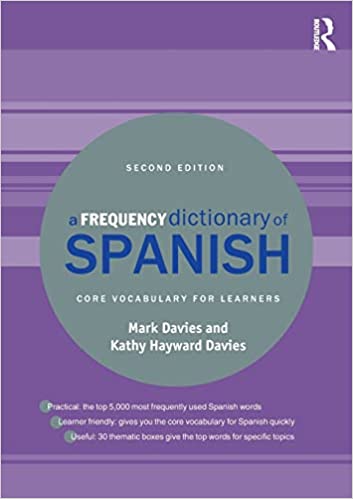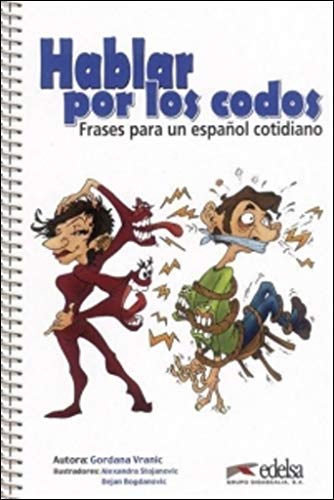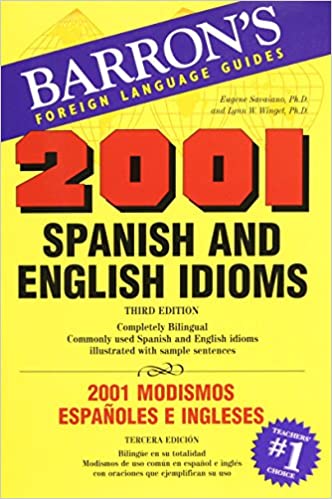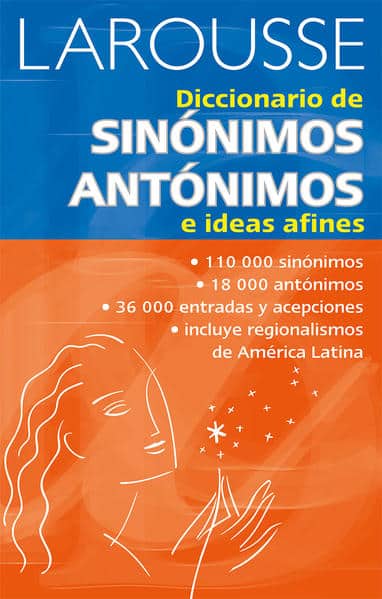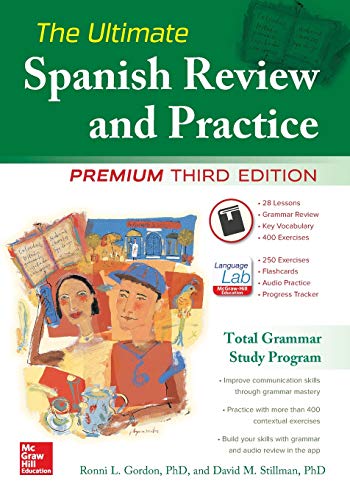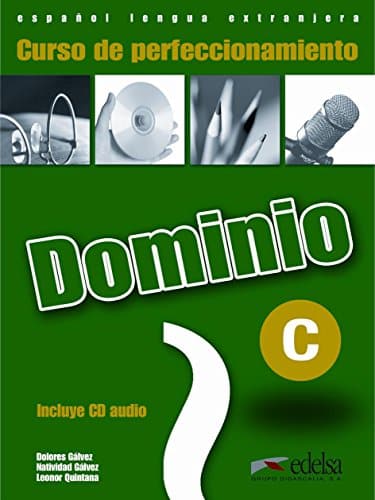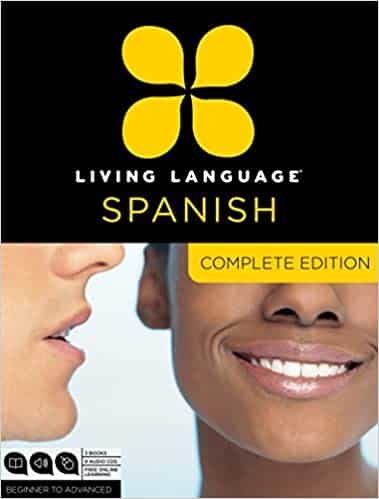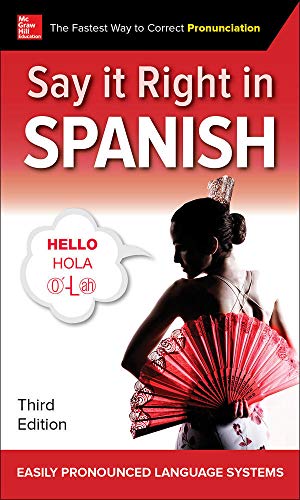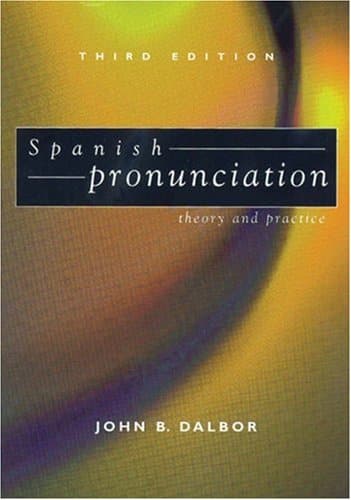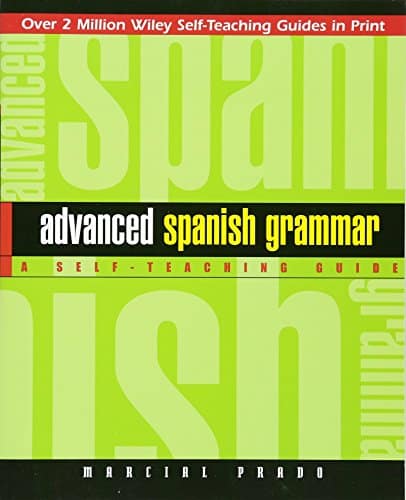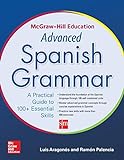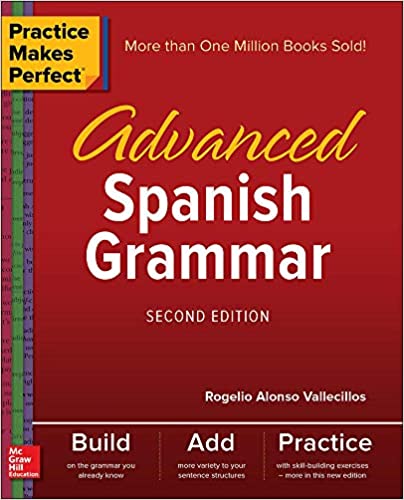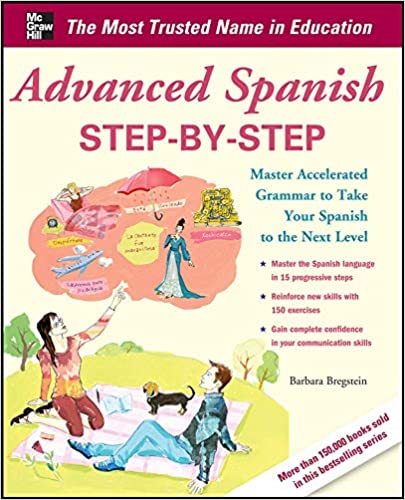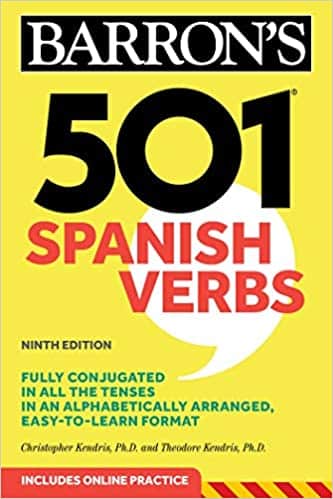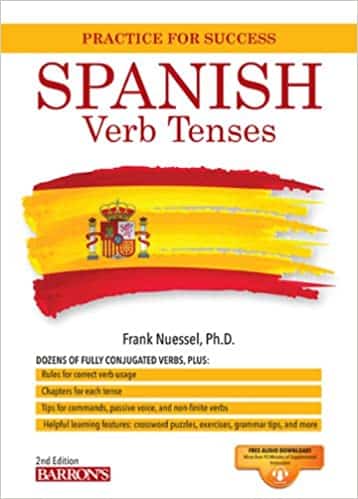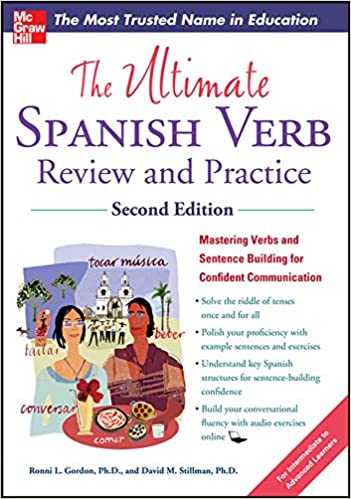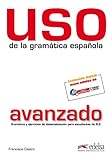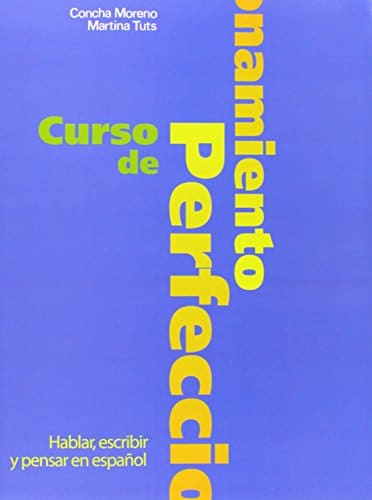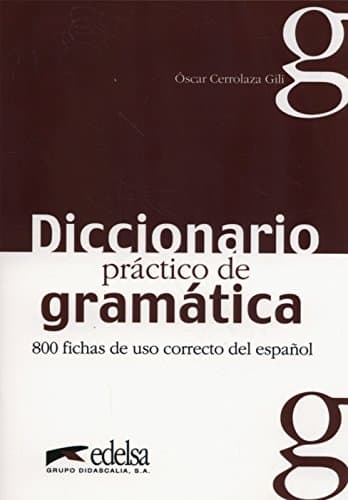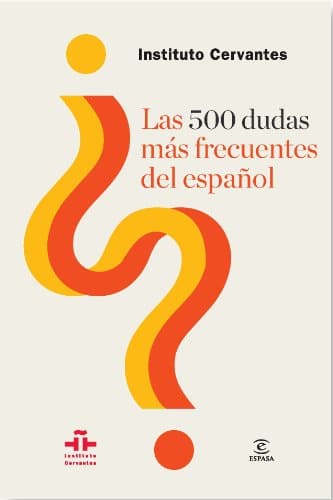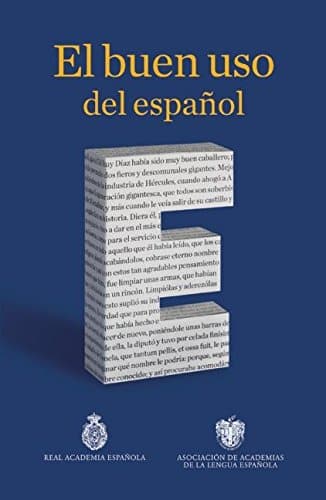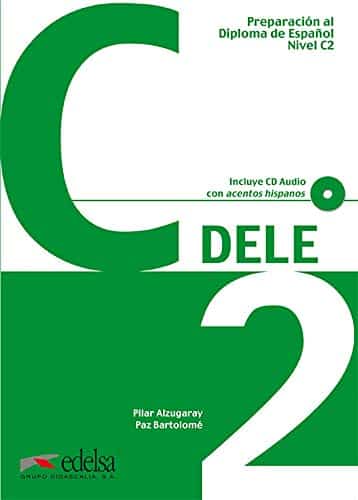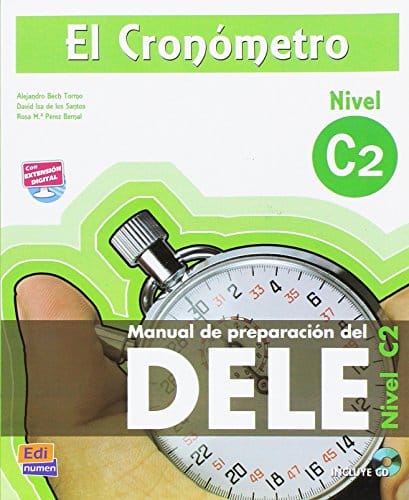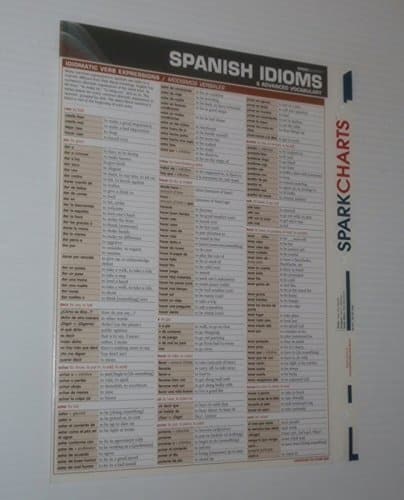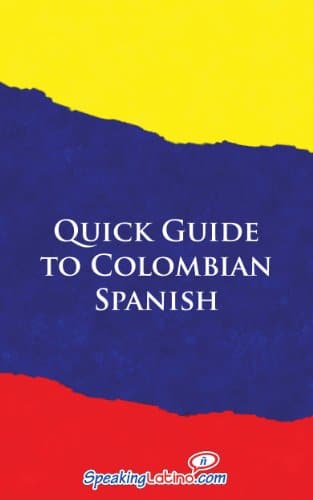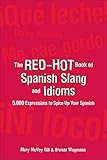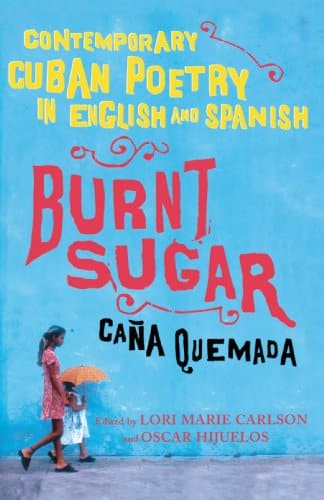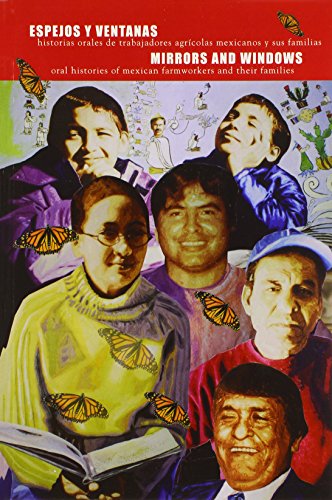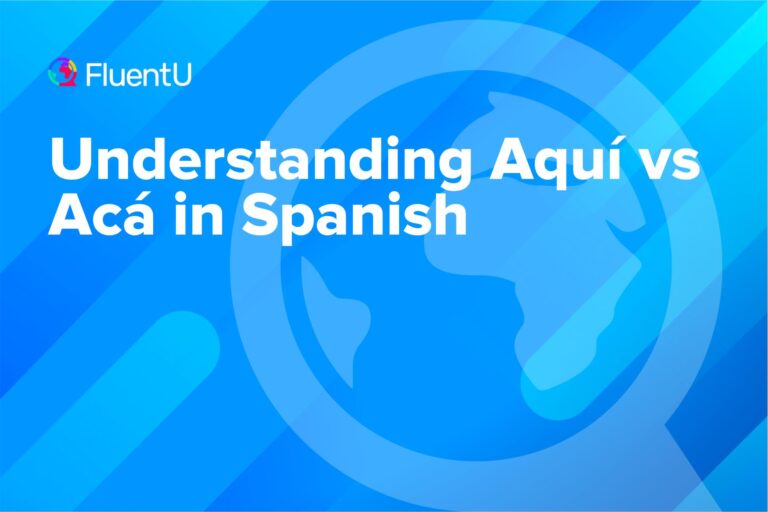Contents
- 1. “Palabra por palabra”
- 2. “The Big Red Book of Spanish Vocabulary”
- 3. “A Frequency Dictionary of Spanish: Core Vocabulary for Learners”
- 4. “Hablar por los codos: Frases para un español cotidiano”
- 5. “2001 Spanish and English Idioms: 2001 Modismos Espanoles e Ingleses”
- 6. “Larousse Diccionario de sinónimos, antónimos, e ideas afines”
- 7. “The Ultimate Spanish Review and Practice”
- 8. “Nuevo Prisma”
- 9. “Dominio: Curso de perfeccionamiento”
- 10. “Living Language Spanish”
- 11. “Say It Right in Spanish!”
- 12. “Spanish Pronunciation: Theory and Practice”
- 13. “Advanced Spanish Grammar: A Self-teaching Guide”
- 14. “Advanced Spanish Grammar”
- 15. “Practice Makes Perfect: Advanced Spanish Grammar”
- 16. “Advanced Spanish Step-By-Step”
- 17. “501 Spanish Verbs”
- 18. “Spanish Verb Workbook”
- 19. “The Ultimate Spanish Verb Review and Practice”
- 20. “Uso de la grámatica española”
- 21. “Curso de perfeccionamiento: Hablar, escribir y pensar en español”
- 22. “Diccionario práctico de gramática: 800 fichas de uso correcto del español”
- 23. “Las 500 dudas más frecuentes del español”
- 24. “El buen uso del español”
- 25. “Manual de la nueva gramática de la lengua española”
- 26. “Preparación DELE”
- 27. “El cronómetro”
- 28. SparkCharts
- 29. Language Babel Quick and Dirty Guides
- 30. “Chilenismos: A Dictionary and Phrasebook for Chilean Spanish”
- 31. “Red-Hot Book of Spanish Slang: 5,000 Phrases to Spice Up Your Spanish”
- 32. “Dictionary of Spanish Slang and Colloquial Expressions“
- 33. “The Essential Neruda: Selected Poems” (Bilingual Edition)
- 34. “Caña quemada” (“Burnt Sugar”)
- 35. “Espejos y ventanas” (“Mirrors and Windows”)
- Choosing the Right Advanced Spanish Books
- And One More Thing…
35 Best Advanced Spanish Books for Learners

How can you push yourself beyond advanced Spanish? A little more formal study might be the boost you need to get you where you’re going.
Here, we’ve provided all the best learning textbooks, reference books and dual-readers for advanced Spanish learners.
Download: This blog post is available as a convenient and portable PDF that you can take anywhere. Click here to get a copy. (Download)
We’ll begin with the section of formal learning books:
1. “Palabra por palabra”
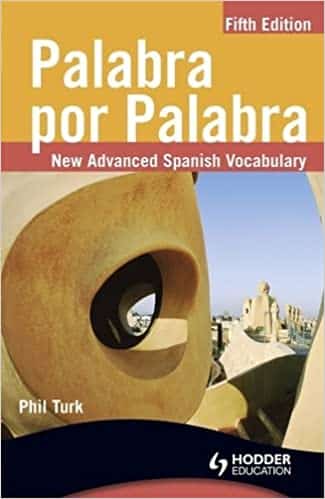
It’s the language of popular culture. If you’re looking to learn how to say oddly specific things like “swine flu,” you’d usually have to wait until the situation arises—and then it’s already too late.
2. “The Big Red Book of Spanish Vocabulary”
This is the big bad granddaddy of Spanish vocabulary. Anything, absolutely anything you need to learn is in this massive collection of useful words, and it’s beautifully organized for easy studying and reference.
3. “A Frequency Dictionary of Spanish: Core Vocabulary for Learners”
This book is an up-to-date frequency dictionary which provides a list of the 5,000 most commonly-used words in the idioma (language).
Every entry comes with an English equivalent and a sample sentence. Note yet another very interesting feature: 30 thematically-organized lists of frequently-used words on a variety of topics (animals, weather, materials, family, etc.) on top of the 5,000 most common words list.
Those features make this dictionary a very handy reference to build one’s vocabulary up. You could, for example, learn the 20 most common words of every thematic list or the 50 most used words for every letter!
4. “Hablar por los codos: Frases para un español cotidiano”
Oriented for European Spanish, this book published by Edelsa contains 175 idioms and 45 refrains to add a colorful, natural dimension to everyday speech.
Each listing contains an illustration of the literal meaning of the phrase, an explanation of the actual meaning and sentences that naturally use said expression in context. Since this book is updated every year, readers are assured that they’re learning phrases and sayings that are currently used by native speakers.
5. “2001 Spanish and English Idioms: 2001 Modismos Espanoles e Ingleses”
Spanish idioms and lumfardo (slang) will seriously enrich your Spanish skills. This book, which focuses more specifically on idioms, is divided in two parts.
One part is about Spanish idioms with their English equivalents. The second part features English idioms with their Spanish equivalents.
By the way, be prepared for some good laughs when you find out the Spanish equivalent of some of our English expressions. Discovering that “the last straw” is translated into “eramos mucho y parió la abuela” (we already were a big group of people and then grandmother arrived) is priceless!
6. “Larousse Diccionario de sinónimos, antónimos, e ideas afines”
This pocket-sized dictionary is one the most useful (and cheapest) Spanish dictionaries for advanced students. With about 36,000 entries, 110,000 synonyms and 18,000 antonyms, this diccionario (dictionary) is an absolutely wonderful resource for any writing or translation work you may need to get done.
The presence of sinónimos (synonyms) and antónimos (antonyms) is incredibly helpful for improving one’s vocabulary. Just by looking for one word, you may end up learning 3-5 more new words.
Here’s another cool feature: it’s indicated when a specific word has a different meaning in other countries (in Latin America versus in Spanish, for example).
7. “The Ultimate Spanish Review and Practice”
This workbook provides a comprehensive review of the Spanish language for English-speaking learners. It’s designed around grammar and vocabulary review for practical, everyday usage, with an emphasis on conversational exchanges. The various topics discussed among its 28 chapters consist of various grammatical concepts as well as idiomatic uses and common errors.
I personally used this book early on. Through pre- and post-tests, audio exercises and a record/replay function to compare your pronunciation to native speakers, “The Ultimate Spanish Review and Practice” is fully equipped to review and improve every aspect of one’s Spanish proficiency skills. It’s ideal for self-study or as a supplement to formal lessons.
8. “Nuevo Prisma”
With books available for both self-study and classroom settings alike, the nuevo Prisma series was designed with a strong focus on improving communication skills. Each book has been designed according to the Plan Curricular del Instituto Cervantes (PCIC), which in turn is structured to align with the standards set by the Common European Framework of Reference for Languages (CEFR).
This resource is available for all levels of Spanish. The self-study exercise book is focused on grammar exercises and preparation for the DELE. The classroom book is focused on integrating grammar and vocabulary into everyday situations, with a strong emphasis on conversation both inside and outside the classroom. More activities and resources are available online and with an optional CD-ROM.
You could also look on Amazon for the teacher’s book for additional features.
9. “Dominio: Curso de perfeccionamiento”
Created by Edelsa with advanced and upper-advanced students in mind (possibly heritage Spanish speakers as well), this resource is focused on mastering the Spanish language. Skills in reading, listening, writing and speaking are developed equally, and in a variety of everyday situations and language contexts as well.
Among other themes, students are taught to perfect various language nuances, expand their lexicon through less commonly used vocabulary, synonyms and antonyms and review idiosyncrasies in written and spoken Spanish.
Each of its ten units are comprised of comprehensive activities that address every aspect of the language. Through diverse exercises, learners perfect their skills through literary extracts, texts and essays from Spain and Latin America.
The student book contains an audio CD, with the answer book sold separately.
10. “Living Language Spanish”
This product is much more than a book. It’s a complete multimedia Spanish learning program composed of 3 books (for beginner, intermediate and advanced learners) designed to be used in combination with 9 audio CDs.
The whole thing is pretty well organized with topic-based chapters featuring new words, sentence structures and conjugations along with high-quality audio recordings.
The program aims to teach you conversational Spanish through a well-balanced combination of vocabulary, grammar, dialogues, questions and exercises. If you’re looking for the advanced material, you might as well head straight to the advanced CDs and books to get right into the good stuff.
11. “Say It Right in Spanish!”
This book is geared more towards beginners and intermediates, but going back to the basics may be exactly what you need to get your pronunciation right.
Pronunciation is something that slips through the cracks for many Spanish language learners—particularly English-speaking learners. A flat American accent can effectively butcher even the most perfect Spanish sentence. Even if you’re speaking fluent Spanish in every other way, many people will still struggle to understand you if you haven’t mastered the Spanish accent.
12. “Spanish Pronunciation: Theory and Practice”
This book contains not only correct pronunciations and easy phonetic guides to train your mouth in Spanish pronunciation, but it also explains the linguistic principles underlying Spanish phonetics. Are you the kind of person who loves to know how things work? Does your brain remember concepts better when you understand them to their very roots? Then this book might be right for you.
As a Spanish learner, you’ll also find grammar reference books and workbooks handy:
13. “Advanced Spanish Grammar: A Self-teaching Guide”
This book is designed to challenge your Spanish. The entire text is written in Spanish, meaning you’ll never be able to slip back into English mode. It works as an all-around grammar study guide and reference book, since no topic is left off the index.
You’ll be able to go right back to the very beginning if need be, starting at -AR, -ER and -IR verb conjugations. This book gives plenty of tests to help you review your knowledge and practical understanding, making it our number one choice for grammar learning and practice.
14. “Advanced Spanish Grammar”
This book by McGraw-Hill Education is truly the gold standard in Spanish grammar. It’s a great reference guide for when things get sticky, or when you’d like to solidify your understanding of a particular grammar topic. Given its bilingual vocabulary glossary, grammar glossary and well-organized index, this book is our selected recommendation for grammar reference.
15. “Practice Makes Perfect: Advanced Spanish Grammar”
The “Practice Makes Perfect” series is pretty well-known for presenting clear, concise, down-to-earth and practical books.
The purpose of this textbook is to take an upper-intermediate to advanced level estudiante (student) beyond the fundamental principles of Spanish grammar. It’ll help you to create meaningful and complex sentences so you can communicate more naturally.
In addition, the book goes way beyond Spanish tenses as it tackles adjectives, adverbs, idiomatic constructions, reported speech and relative pronouns among other things.
This book is available on VitalSource, a convenient e-book resource for cheap and digital learning materials.
16. “Advanced Spanish Step-By-Step”
This book is the one that follows the popular beginner “Easy Spanish Step-By-Step” book. This advanced volume is designed to give you the tools you need to reach advanced Spanish proficiency quickly.
It starts off with a quick overview of key grammar basics to refresh your memory before going into a complete coverage of verb tenses. Then, you’ll be introduced to hundreds of new words reinforced with readings to put them into context. This is the ultimate method for absorbing new vocabulary, as the memorable context will help root words in your brain.
17. “501 Spanish Verbs”
This 9th edition of the infamous Barron’s Spanish verb book shows you how to use the 501 most common and useful Spanish verbs in all 15 tenses and moods.
Each verb is listed alphabetically (one verb per page) with its English translation, synonyms, antonyms and examples of usage. You’ll also find lots of exercises with answers to guide you along.
This book is a wonderful resource for irregular verbs and keeping all the tenses straight. This is definitely one of the most comprehensive, most well-organized and most detailed Spanish verb reference books you’ll find on the market.
18. “Spanish Verb Workbook”
This workbook is what you’ll need to train yourself on the correct verb usages in español.
Verbs are presented with fundamental conjugation information along with illustrative dialogues. The book features exercises to help you master everything from basic tenses like present, present progressive or imperfect to more advanced forms like conditional perfect, imperfect subjunctive, present perfect subjunctive, pluperfect subjunctive, commands, passive voice, non-finite verb forms and much more!
If you’re an advanced student who wants to dive deeper into the language, this book should please you and help you achieve your goal.
19. “The Ultimate Spanish Verb Review and Practice”
This most excellent Spanish verb guide provides you with a concise review of the different verb forms along with extensive practice by using verbs in context. You’ll find a large variety of exercises like sentence completion, sentence building, dialogue writing, translation, verb-form replacement, etc.
This uniquely thorough practice guide will be your best friend. It’ll help you get from using simple “subject + verb” sentences to more sophisticated phrases including conditional and compound tenses. It’ll be an excellent long-term investment that’ll help you get all the nuances you might not have understood so far.
20. “Uso de la grámatica española”
This series is available in 3 levels: elemental, intermedio and avanzado. Unlike the other books on this list, this book is completely focused on grammar. No texts, articles, cultural notes or vocabulary lessons grace the pages of this resource.
Ideal for self-study, this may be ideal for those who want to focus on their grammar without additional tidbits as a distraction. This minimalist resource includes an explanation of each grammar point, as well as charts, tables and numerous exercises. The advanced book contains lessons on 22 grammar topics, while the beginner and intermediate books contain 35 and 31, respectively. Answers are sold separately.
21. “Curso de perfeccionamiento: Hablar, escribir y pensar en español”
This workbook is designed for upper-intermediate to advanced learners who have reached a plateau in their grammar studies. Great for both self-study and classroom use, this resource helps students perfect the rules and idiosyncrasies of grammar that are typically passed over in beginning and intermediate level classes.
Through meticulous explanations (e.g. several chapters are dedicated to the subjunctive), comprehensive written exercises yet relatively brief thematic sections, students are given the opportunity to thoroughly grasp advanced grammar and apply their newly-learned language to complex, real-world situations.
A variety of texts are used throughout the book, many of which were taken from Spanish-language newspapers and books. Numerous grammar and vocabulary exercises are provided, both as stand-alone language review and as supplements to the aforementioned texts and articles. Answer book sold separately.
22. “Diccionario práctico de gramática: 800 fichas de uso correcto del español”
This resource alphabetically lists 800 grammar concepts regarding los operadores del discurso más frecuentes e importantes del español, as the author succinctly states.
Each grammar point contains an in-depth explanation of what the word or concept means and how to accurately utilize it. A description of the grammar point and two example sentences with the word being used in context start each section. Then the grammatical significance (e.g. locución adverbial de hipótesis) and syntactical rules (e.g. se utiliza con un verbo en Indicativo) are explained. When necessary, the use and register of the phrase are given.
The final portion of many grammar points includes a helpful section which compares said phrase to other similar or contrasting phrases. An exercise book with a separate answer key can also be purchased on Amazon.
23. “Las 500 dudas más frecuentes del español”
Published by Instituto Cervantes, this book focuses on the most common questions that arise among (generally native) Spanish speakers. Each of the 500 dudas is accompanied by a detailed answer addressing every aspect of that particular concern. Not only is the answer to each question explained in great detail, but the authors also describe situations in which said language point may be used, as well as why a particular concern is correct, incorrect or correct, depending on the context.
As the authors seem to understand that linguistic analyses may not suit everyone, correct and incorrect sentences are given in each entry. This allows readers to directly compare and contrast how a particular thought is expressed, especially as the incorrect example is typically a common mistake made by native speakers. When appropriate, the preferred vs not-so-ideal ways to write a sentence are also provided.
24. “El buen uso del español”
Published by the Real Academia Española and the Asociación de Academias de la Lengua Española, this is a comprehensive, yet brief, guide to the Spanish language. As quoted from the Introduction chapter of the book:
Está destinado a la inmensa mayoría, a todos los hablantes que experimentan dudas e incertidumbres ortográficas o gramaticales ante la lengua. Está pensado y organizado para que el acceso a la información sea rápido, el tiempo de consulta sea breve y la explicación resulte intuitiva, clara y suficiente.
With 224 blocks throughout 500+ pages, it’s a quick guide of virtually every aspect of the Spanish language from phonemes to comma usage to capitalization to interrogatives con y sin tilde to perífasis verbales and locuciones.
25. “Manual de la nueva gramática de la lengua española”
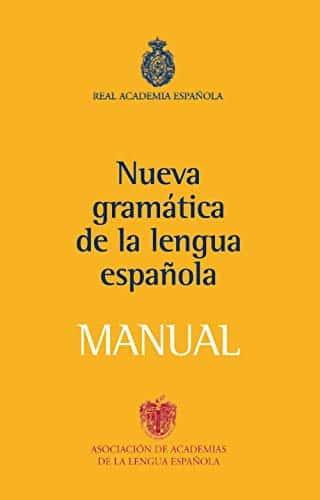
This book, also published by the Real Academia Española, is an academically-oriented resource developed to review the complexities of Spanish grammar. This 1000-page linguistic tome is geared towards proficient speakers with a passion for grammar or a need for linguistic precision in their Spanish usage.
It isn’t meant to be used as a learner’s guide, but rather a comprehensive, technical, systematic grammar manual for language professionals and aficionados. Those of us who are language teachers, translators, writers or linguists who speak European or Latin American Spanish may appreciate the linguistic depth of this book.
Need to prepare for the DELE? These resources are designed for students who are studying for the internationally-recognized Spanish proficiency exam. All are ideal for self-study, although they would also provide an excellent supplement to a formal DELE course.
26. “Preparación DELE”
This series is available for every level of the DELE, including C2. Each book is separated into six themes, each of which contains a sample exam and corresponding vocabulary. An audio CD is included for the listening section of the exam.
In my opinion, this should not be the only resource that you use to prepare for the exam. Although it has many practice exams and exercises, there’s little in the way of test-taking methods and strategies.
27. “El cronómetro”
“El cronómetro,” published by Edinumen, is filled with both sample exams as well as numerous strategies and pautas to prepare its readers for the complexities of the DELE.
As the authors seem to realize that not every learner is the same, this resource provides a variety of suggestions so students can determine which methods work best for them. The book contains four complete sample exams, although the amount of texts and other questions through this resource are supposedly equivalent to eight sample exams.
An audio CD is included.
With all these books from the world of formal learning, we’re now shifting our focus to modern, real-world Spanish:
28. SparkCharts
Remember that time you couldn’t finish “A Tale of Two Cities” (or insert lengthy classic work here) and just glanced at the SparkNotes before the exam? If you have a memory like that, then you’re totally going to love SparkCharts. This is pretty much the same thing, except you’re SparkNoting the language and culture of the entire Spanish-speaking world. It’s the lazy way to study and refer back to advanced Spanish vocabulary, idioms and expressions.
Let’s take an example of how this chart will come in handy. You probably know the majority of important prepositional phrases, but every now and again you’ll have trouble recalling which phrase uses which preposition (“Is it cerca a or cerca de?”). This chart is well-organized and easy to scan for quick reference for little details like these.
29. Language Babel Quick and Dirty Guides
This is a series of quick and dirty guides to slang, idioms and expressions found all over the Spanish-speaking world. To get the most out of this series, choose the book that corresponds to the country you plan to speak Spanish in. There is a book for each of the following Spanish dialects: Mexican, Dominican, Colombian, Venezuelan and Peruvian.
30. “Chilenismos: A Dictionary and Phrasebook for Chilean Spanish”
Anyone who’s had the distinct pleasure of speaking with a Chilean knows that Chilean Spanish is a whole different animal. The language spoken in-country has an insanely different pronunciation, consonants are dropped indiscriminately, words are blurred together in rapid-fire succession and the vocabulary is, well, unique. If you’re planning to spend any time in Chile, save yourself the initial frustration of having to adjust to this new Spanish and bring this book along with you.
For a more general Spanish phrasebook, look to Lonely Planet. They have a few other regional options, like Mexican, Costa Rican and Latin American Spanish phrasebooks. But the real meat and potatoes is their classic Spanish phrasebook, which comes complete with audio pronunciation and app access—and the app even has an instant translation feature and a special decoder for Spanish restaurant menus. Ah, modern living!
31. “Red-Hot Book of Spanish Slang: 5,000 Phrases to Spice Up Your Spanish”
This book is all about quantity. You will literally never miss another Spanish slang word as long as you should live. What it lacks in organization it makes up for with diversity. This is best for those learning Spanish in their home country, with little opportunity to speak in the Spanish-speaking world. It’ll broaden your linguistic horizons and introduce you to the more colorful elements of the Spanish language from afar.
32. “Dictionary of Spanish Slang and Colloquial Expressions“
Now, let’s say you’re planning a lengthy trip throughout various countries in Latin America. You don’t really want to buy a book for every individual country, but you also don’t want a giant, high-quantity book like the previous one. What you really want is an organized reference book that will provide you with the language you need for each country on your itinerary.
This dictionary has a respectable quantity of Spanish slang (~4,000 terms), and is organized both alphabetically and by country/region. Each entry also contains a sample sentence to demonstrate how to properly use the word in context.
We’re now leaving the world of modern language and entering the realm of fine Spanish literature.
At an advanced level of Spanish, your main concern with reading should be smoothness and speed. As your eyes scan a Spanish text, are you hitting little speed bumps here and there that stop you from becoming totally immersed?
The following texts are all bilingual—or dual-readers—which contain both Spanish works and their English translations. This means that you can simply check the English version of the poems and gauge your comprehension of the text without having to break concentration and consult a dictionary.
33. “The Essential Neruda: Selected Poems” (Bilingual Edition)
To take a few baby steps into the world of Latin American literature, read this smattering of beautiful, timeless poems by this Chilean Nobel Prize winner. The romantic language flows naturally, and the vocabulary often stays thematically consistent within one particular poem.
For the majority of his poems, Neruda’s language circles around passionate love and nature. While he deals with the complex issues of human nature, the language is the perfect level for advanced students. You’ll find plenty of familiar, simple language, tons of cognates and a few obscure words thrown in the mix to keep things interesting.
Reading both the English and Spanish versions is equally helpful for your overall cultural awareness because Neruda’s work has found a place in the popular culture of the English-speaking world as well. And Neruda scholars the world over are in agreement here—this hand-picked collection is a great starter kit for those interested in further exploring Neruda’s written works.
34. “Caña quemada” (“Burnt Sugar”)
To transport yourself to the sun-soaked streets of Havana, look no further than “Caña quemada,” a collection of Spanish language poems by contemporary Cuban and Cuban-American authors. All the poems have been translated into English for this particular anthology.
With tales of familial ties, old friends, love, coming of age, seasonal changes, farming sugarcane and island living, you’ll come away feeling an echoing, poignant nostalgia that makes you long for the sights, sounds, smells and tastes of an island nation you’ve probably never visited.
This book was a Christmas gift from my mom when I was first enthusiastically learning Spanish in high school, and it imprinted itself on my memory. I hope it will do the same for you.
35. “Espejos y ventanas” (“Mirrors and Windows”)
This book is less of a dual-reader and more of a bilingual piece of literary art. The author sought complete and full expression by writing in both English and Spanish. It throws open a huge, airy, floor-to-ceiling window to the issues faced by modern Mexican and Mexican-American people. It was born of a storytelling project which aimed to illustrate the lives of immigrants and their families. The text is really just a transcription of oral histories, so the featured individuals themselves speak clearly, strongly and in their own voices.
It’s a perfect reading choice if you’d like to gain a fresh perspective on immigration issues in the United States—or if you’d just like to read stories of family loyalty, language barriers, cultural confusion and second-generation Mexican-Americans discovering their own unique identities. Because the book is derived from spoken stories, the Spanish used is even more casual and straightforward, allowing for greater ease of reading.
Choosing the Right Advanced Spanish Books
The books we’ve recommended fall into three major categories:
- Formal learning (vocabulary and grammar)
- Modern, real-world Spanish
- Literature for Spanish immersion
With the first category, you’ll hone the skills you’ve previously developed in terms of grammar, vocabulary and pronunciation.
In the second, you’ll fill in all the little details that you might have found missing while watching Spanish television, reading Spanish magazines or chatting with native speakers. They’re also a nice supplement to video-based immersion programs like FluentU.
In the third, you’ll put all of your Spanish learning into practice, improve your reading comprehension and boost yourself to overall Spanish fluency.
While they all tackle different subject areas, these books share a few major characteristics:
- Reputable. These books are all published by well-known and trusted publishers, have received excellent user reviews and have been assessed first-hand by yours truly.
- Thorough. Nothing slips through the cracks with these books. The whole point is to track down those oft-forgotten little details that differentiate the advanced students from the fluent speakers. You’ll be attacking Spanish from all possible angles, to ensure the fastest advance to fluency.
- Relevant. The content is practical knowledge that you should store away for future encounters with the Spanish-speaking world.
A mix of sources from different categories will help give you a broad understanding of the language, while also keeping your interest up as you study.
The books listed above are just the nudge you were looking for to glide your advanced Spanish all the way to fluency.
Download: This blog post is available as a convenient and portable PDF that you can take anywhere. Click here to get a copy. (Download)
And One More Thing…
If you've made it this far that means you probably enjoy learning Spanish with engaging material and will then love FluentU.
Other sites use scripted content. FluentU uses a natural approach that helps you ease into the Spanish language and culture over time. You’ll learn Spanish as it’s actually spoken by real people.
FluentU has a wide variety of videos, as you can see here:

FluentU brings native videos within reach with interactive transcripts. You can tap on any word to look it up instantly. Every definition has examples that have been written to help you understand how the word is used. If you see an interesting word you don’t know, you can add it to a vocab list.

Review a complete interactive transcript under the Dialogue tab, and find words and phrases listed under Vocab.

Learn all the vocabulary in any video with FluentU’s robust learning engine. Swipe left or right to see more examples of the word you’re on.

The best part is that FluentU keeps track of the vocabulary that you’re learning, and gives you extra practice with difficult words. It'll even remind you when it’s time to review what you’ve learned. Every learner has a truly personalized experience, even if they’re learning with the same video.
Start using the FluentU website on your computer or tablet or, better yet, download the FluentU app from the iTunes or Google Play store. Click here to take advantage of our current sale! (Expires at the end of this month.)
